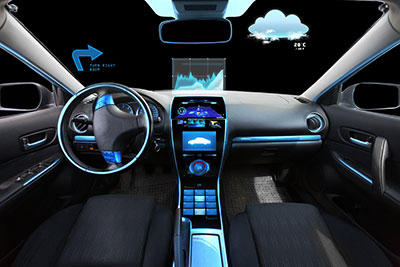Wireless connectivity technology is everywhere nowadays, and Bluetooth plays a significant role in this ecosystem. So if you are walking around town with your phone's Bluetooth in discoverable mode, it is possible to locate you. But Bluetooth device identification has several benefits, and we will explain how practical it is in the modern world. Let's get right into it!
Contents
How Bluetooth Works
Bluetooth devices communicate using ISM (Industrial, Scientific, and Medical devices), a free 2.4GHz radio frequency band. The unlicensed band has low power requirements, meaning Bluetooth devices like headsets, keyboards, mice, and other accessories consume little battery power.

A Bluetooth headset
The Bluetooth SIG (Special Interest Group) licenses Bluetooth technologies and oversees the development of the technology's standards globally.
Bluetooth Security Features
Bluetooth's basic security feature is its discoverable and non-discoverable modes in a device's settings.
The second security layer is in the pairing function. Once devices are discoverable and you pick a device to connect to on the list, it will ask you to type a code shown on the screen. This feature verifies that you and the other remote device agree to connect and share information.

Pairing a smartphone with a vehicle’s multimedia audio system
Simple devices like headphones usually don't have a security code for pairing. They store the identification for the other gadget as a remembered device.
Special Offer: Get $200 off your order!
Email [email protected] to get started!
What is Bluetooth Surveillance?
If several Bluetooth devices have their discoverable mode switched on, they can locate nearby devices if they are within range (about 10 meters or 33 feet). Each gadget has a unique 48-bit identifier, which is in the form of a 6-byte address in this format: (01:23:45:67:89:10). The first three bytes identify the device manufacturer, while the last three identify the device.

A wireless Bluetooth music receiver
Bluetooth surveillance involves placing several Bluetooth-enabled receivers for broad coverage. These receivers track the position of discoverable wireless devices that are within range. They record and send the identifier data back to the receiver, which identifies the gadget itself and the manufacturer.
Additionally, these beacons can identify which way you are moving by analyzing the signal strength.
Therefore, to have a reliable Bluetooth surveillance network, say along a 200-meter-long stretch in a park, you need to install ten receivers 20 meters apart.
Bluetooth Positioning and Tracking
Bluetooth surveillance might seem intrusive because it can track your movement without consent. But remember, it only works if the discoverable mode is on. And most devices require pairing to gain access to a device. So the technology can be intrusive, but still with safety features that deter complete access and spying.
Why Bluetooth Device Identification Is Important
Tracking people via their Bluetooth devices has several applications that don't infringe on the privacy of individuals.
For instance, the Aalborg zoo in Denmark implemented one of the pioneer Bluetooth tracking systems in 2003. But it was not for surveilling the visitors. Instead, the zoo provided BlueTags to parents to attach to their children. Bluetooth receivers installed around the zoo could track the children's movement and locate them if they wander off.

A Bluetooth hands-free car kit
This type of device detection is also typical in most retail environments, such as shopping malls. They use the system to follow shoppers to create general maps of their movement and check how long they stay in certain areas.
Another retail environment application is the case of the giant mall of America in Minneapolis, Minnesota. In 2018, the mall installed a Bluetooth beacon infrastructure and developed a mobile application for the system. Shoppers could pick their destination on their mobile devices and pinpoint their location in the mall.

An illustration of Bluetooth beacon technology
The app then directs the customers and provides extra information, such as vertical transportation aspects (escalators), estimated arrival time, and store hours.
Other Applications
You might be more familiar with Tile Trackers or Apple Inc's AirTags, which help track items you often misplace, such as keys. Cellular phone apps can show where the tag is to locate the item. The tags can also help you find your bags or help prevent theft if your bag moves away from your location.
Another critical application is IoT. Bluetooth Low Energy (BLE) is typical in IoT devices due to its low energy and broad compatibility. And the application layer for the Mesh Profile Bluetooth Specification supports message authentication and data encryption for IoT networks.
Therefore, you can use mobile applications to turn fans and coffee makers on before getting out of bed.

Bluetooth earbuds
Typical Bluetooth Lingo
You might come across some Bluetooth-related terms when dealing with this technology, and the most typical ones include the following.
Bluesmacking
Bluesmacking is a DOS (Denial of Service) attack that involves sending enormous data traffic to a device to try to shut it down.
Bluejacking
This technique is more of a prank that involves sending unsolicited text messages to a person's mobile phone. It is annoying and ideal for a phishing attack.

A blue Bluetooth speaker
Bluesnarfing
Bluesnarfing infringes on privacy seriously. It refers to a scenario where attackers read, copy, or change information on a person's mobile phone. An example is accessing a person's address book, calendar, phone book, etc.
Bluebugging
A Bluebugging attack installs a backdoor on your cellular phone or Bluetooth device for someone else to gain access to your private information.
Wrap Up
In conclusion, Bluetooth wireless network technology has become a popular standard for connecting most wireless devices due to its worldwide availability and low power requirements. And it has made Bluetooth device identification feasible for several applications, such as the ones shown above. That's it for this article. If you have any questions or comments, get in touch, and we'll get back to you asap.
Special Offer: Get $200 off your order!
Email [email protected] to get started!






